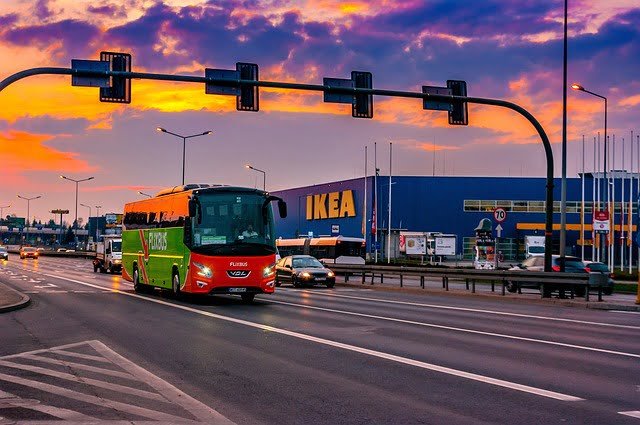
Preparing Products for Internationalization | Internet Development
Table of Contents
Development of Internet and Preparing a Product for Internationalization-Part 1
Introduction:
Today, we’re diving into the world of the Internet’s growth and how to get a product ready for selling around the world.
We’ll check out how the Internet has changed things and how businesses can go global. Think of it like exploring a big digital map that helps products reach places they’ve never been before. We’ll talk about what works and what challenges businesses face when they want to sell their stuff everywhere. So, let’s jump in together and figure out how technology and business come together in this global adventure!

Importance of the Internet in Today’s Global Marketplace [Preparing Products for Internationalization | Internet Development ]
1. Global Communication
The Internet makes it easy for businesses to communicate with customers and partners worldwide. Social media platforms like Facebook, Twitter, and Instagram allow companies to interact directly with their audience. For example, in the Philippines, brands like Jollibee use these platforms to connect with customers, answer questions, and share updates. This creates a sense of community and builds trust between businesses and their customers.
2. Marketing
Social media and online platforms have transformed how businesses promote their products. Companies can now showcase their offerings to a global audience through posts, videos, and ads. For instance, Bench uses Instagram to share its latest clothing collections, while Jollibee uses Facebook to promote its meals. These platforms help businesses reach more people without needing expensive traditional advertising.
3. Commerce (Selling Products Online)
E-commerce platforms like Shopee and Lazada allow businesses to sell products online, reaching customers far beyond their physical locations. ZALORA is an excellent example of this in the Philippines—its online store serves local shoppers and attracts international buyers interested in Filipino fashion.
4. Diverse Audience Reach
The Internet breaks down barriers, enabling even small businesses to access global markets. For example, local Filipino brands can sell on international platforms or attract tourists looking for unique items online. This allows businesses of all sizes to compete on a larger scale.

Preparing Products for Internationalization | Internet Development
5. Transaction Streamlining
Online payment systems like GCash and PayMaya make buying and selling faster and more convenient. Customers can pay instantly without cash, and businesses can process transactions efficiently. This helps both buyers and sellers save time.
6. Supply Chain Optimization
Businesses use the Internet for inventory management and logistics. For example, Mercury Drug uses cloud-based systems to track stock levels and ensure they never run out of essential items. This improves efficiency and prevents delays.
7. Collaboration Tools
Platforms like Microsoft Teams allow employees to work together even if they are in different locations. This is especially useful in the Philippines, where team members may be spread across islands but can still collaborate effectively through online tools.
8. Competitive Edge
The Internet gives businesses an advantage by helping them innovate and stand out from competitors. Revolution Precrafted uses online platforms to sell prefab homes creatively, while PawnHero offers online pawnshop services that are more convenient than traditional ones.
9. Business Growth
By embracing digital tools, companies can expand faster and reach more customers. Online platforms open up new opportunities for revenue streams and partnerships that were not possible before.

Introduction to Internationalization of Products [ Preparing Products for Internationalization | Internet Development ]
Internationalization is the process of preparing products or services to reach global markets. Think of it as giving your product a passport to explore and thrive beyond its home country. It goes beyond simple expansion—it involves adapting to cultural differences, strategic planning, and creating growth opportunities.
Here’s a breakdown of what internationalization entails:
1. Process of Expanding Products/Services Beyond Domestic Borders
Internationalization allows businesses to grow beyond their local markets. For example, the South Korean tech giant Samsung didn’t limit itself to selling gadgets in Seoul. Instead, it expanded globally, making its smartphones and home appliances available on every continent. This process enables companies to break free from domestic limitations and compete globally.
2. Adapting to Diverse Markets and Cultural Nuances
Successful internationalization requires adapting products to local cultures and preferences. McDonald’s is an excellent example of this adaptability. In India, where many people prefer vegetarian options, McDonald’s introduced the McAloo Tikki Burger—a veggie-friendly menu item tailored to local tastes. This highlights the importance of understanding cultural differences when entering new markets.
3. Enabling Growth, Revenue Diversification, and Brand Expansion
Expanding internationally helps businesses grow, diversify their revenue streams, and strengthen their brand presence. IKEA exemplifies this by moving beyond its Swedish roots to furnish homes worldwide. Its global reach has not only increased revenue but also solidified its reputation as a leading furniture brand across continents.
4. Strategic Planning and Market Research for Success
Entering new markets requires careful planning and research. Toyota’s success in international markets is a result of its strategic approach. Before launching in the Netherlands, Toyota identified the demand for eco-friendly vehicles and positioned itself as a leader in hybrid cars. This demonstrates how understanding local market needs is key to succeeding globally.

Preparing Products for Internationalization | Internet Development
5. Importance of Product-Market Fit
Before expanding internationally, companies must first ensure their products meet their domestic market’s needs. Without strong product-market fit at home, global expansion may face challenges. Businesses should assess their product’s performance through feedback and testing before venturing into foreign markets.
6. The Role of Localization
Internationalization lays the groundwork for localization—adapting products for specific regions or cultures. Localization involves more than just translating text; it includes adjusting design, colors, and features to suit local preferences while maintaining the product’s core identity.
7. Challenges of Direct Translation
Direct translation can lead to miscommunication or cultural missteps in new markets. A notable example is KFC’s slogan “finger-lickin’ good,” which was mistranslated into Chinese as “eat your fingers off.” This translation confused customers and highlighted the importance of cultural sensitivity during internationalization efforts.KFC’s initial attempt to appeal to the Chinese market in the 1980s resulted in a phrase that sounded unappetizing and gruesome rather than enticing. Recognizing the error, KFC quickly worked with local experts to refine its brand message and adapt its menu to fit local tastes better, ultimately leading to its success in China.
8. Framework for Future Adaptation
Internationalization creates a flexible framework that allows companies to adapt their products more quickly when entering new regions later. Businesses can save time and effort during future localization efforts by considering factors like language support, date formats, and regional preferences early on.
9. Long-Term Success Through Internationalization
Ultimately, internationalization opens doors for long-term growth by increasing customer bases and building global brand recognition. By carefully planning expansions while respecting cultural differences, businesses can establish themselves as trusted players in multiple markets worldwide.

Evolution of the Internet Timeline [Preparing Products for Internationalization | Internet Development ]
1969: The digital revolution kicked off with the birth of the Advanced Research Projects Agency Network (ARPANET), the precursor to the internet. Picture it as the internet’s humble beginnings, connecting four major U.S. universities and laying the groundwork for the digital age we now live in.
1989: Tim Berners-Lee, a digital trailblazer, introduced the World Wide Web, transforming how we share and access information. Imagine the internet as a vast library suddenly open to everyone. This breakthrough marked the start of a new era in global communication.
1991: Tim Berners-Lee continued making waves by launching the first web browser, WorldWideWeb (later called Nexus). He handed us a user-friendly map to navigate the rapidly expanding online world.
1994: Netscape Navigator rocked the internet scene, becoming the first widely used consumer web browser. Think of it as the key that unlocked the door to the World Wide Web, making it more accessible and user-friendly.
1997: Social media stepped into the spotlight with Six Degrees, the pioneer in creating profiles and connecting with friends online. While short-lived, it set the stage for the following social media explosion.
1998: Google stepped onto the scene, changing the game in internet search. Larry Page and Sergey Brin’s brainchild revolutionized how we find information online, becoming synonymous with digital exploration.

Preparing Products for Internationalization | Internet Development
2004: Mark Zuckerberg launched Facebook, transforming social networking into a global phenomenon. He handed everyone a digital passport, connecting friends and reshaping how we share our lives online.
2005: YouTube took center stage, revolutionizing how we share and consume online videos. Suddenly, everyone had a platform to showcase their creativity to a worldwide audience.
2007: Apple’s iPhone became a game-changer, propelling mobile internet usage into high gear. The smartphone became our gateway to the digital universe, redefining how we connect, access information, and enjoy media.
2010: Instagram emerged, reshaping social media, and focusing on visual content. Imagine a world where sharing stories became an art form through images, ushering in a new era of digital expression.
2015: Live streaming platforms like Periscope and Twitch transformed online entertainment. Users could now broadcast and engage with live content, creating real-time connections and communities.
2020: The COVID-19 pandemic accelerated the spotlight on e-commerce, highlighting the importance of online shopping and digital transactions. The surge in digital commerce showcased the resilience and adaptability of the digital landscape during challenging times.

Preparing Products for Internationalization | Internet Development
More Stories
- The Farmhouse | Halo-halo | A Review
- Tomongtong Mangrove Eco-Trail: A Review
- ICON Paints & Home Finishes: Your Ultimate Home Upgrade Hub
- Bacolaodiat Festival Schedule of Activities
- Balut: Unwrapping Culinary Culture Through a Blogger’s Lens
- Skin Food Wonders: Transformative Nutrients for a Radiant Glow
- Omega-3 Fatty Acids Rich Foods: The Perks and Privileges
- Muscle Recovery Foods | Fabulous Asian Lifestyle
- Hotel del Sur, Kabankalan City: A Review | Fabulous Asian Lifestyle
- Tractor Cafe, Talisay: A Review | Fabulous Asian Lifestyle




The development of the Internet has revolutionized how businesses prepare for internationalization by offering global market access, enabling instant communication, and facilitating efficient data analysis. Companies can now conduct market research online, access real-time consumer behavior insights, and identify potential markets faster. Key strategies for success include leveraging e-commerce platforms to reach global audiences and using digital marketing to target specific customer segments. Additionally, businesses should focus on building a strong online presence, optimizing supply chains through digital tools, and fostering cultural adaptability to appeal to diverse markets. For example, Nike’s use of online customization tools allows customers worldwide to design personalized products, enhancing their global appeal and customer engagement.
Over the past years the internet has contributed a lot when it comes to technological advances so is the same to internationalization of businesses. It made businesses who wanted to go global in such a more convenient and accessible way, making it more possible for business owners to expand their market. If I were to suggest key strategies for business owners. It would really be to study and learn the culture of what country they are planning to extend their business to. In this way, business owners will be more mindful and will know what approach will be best to continue their operations.
the global reach provided by the Internet, companies can now easily connect with customers worldwide, conduct market research more efficiently, and streamline their operations across borders. Some key strategies that companies can adopt to succeed in global markets include:
1. E-commerce Platforms: Setting up online stores and leveraging e-commerce platforms can help businesses reach a broader audience without the need for physical presence in every market.
2. Localization: Adapting products, services, and marketing strategies to suit the preferences and cultural nuances of specific target markets is crucial for success on a global scale.
3. Digital Marketing: Utilizing targeted digital marketing campaigns, including social media, search engine optimization, and online advertising, can enhance brand visibility and attract international customers.
4. Supply Chain Optimization: Implementing efficient supply chain management practices can reduce costs, improve delivery times, and enhance overall customer satisfaction, especially when dealing with international logistics.
5. Strategic Partnerships: Collaborating with local businesses, distributors, or influencers in target markets can provide valuable insights, resources, and networks to facilitate market entry and growth.
An example of a company that successfully implemented these strategies is “TechGear Solutions,” a tech accessories company based in the United States. By expanding its online presence through e-commerce platforms, customizing products to suit the preferences of different regions, and partnering with local distributors in key markets like Japan and Germany, TechGear Solutions was able to establish a strong global presence and increase its international sales significantly.
The internet has revolutionized internationalization by enabling businesses to conduct market research, reach global customers through commerce, and manage operations remotely, with localization and digital marketing as key strategies for success; for example, Netflix’s tailored content strategy across different countries has fueled its global worth.
The internet has transformed international business by facilitating more market research, affordable digital marketing, and worldwide e-commerce opportunities. Businesses can tap into real-tme data, tailor content for specific regions, and reach global customers through online platforms. Enhanced communication tools and digital solutions have streamlined operations and supply chain management. To thrive internationally, companies should conduct detailed market research, adapt their products and strategies to local markets, comply with regional regulations, and respect cultural differences. Forming local partnerships and offering a personalized customer experience are also crucial for global success. – Alexandrea Morados, ECOMM C46
The development of the internet has significantly transformed the way business prepare for internationalization by providing new tools and strategies to expand toward global markets move effectively and efficiently. Due to the rise of digital marketing companies has revolutionized to promote their product globally through content marketing and social media advertising. Also companies could develop strategic partnerships, such as collaborating with local partners which can help with navigating unfamiliar markets, regulatory landscapes and cultural nuances. Also with Data analytics and market research the availability of vast amount data online allows businesses to analyze consumer behavior, market trends and competitor strategy. With strategic partnership, data analytics and market research has enabled companies helps understand demand, competition and consumer behavior in different markets
Nowadays, the internet plays a huge role in various business cycle. It enables companies to showcase their brand, understand their SWOT( Strengths, Weaknesses,Opportunities, and Threats), and gain insights into their competitors. Additionally, the internet has revolutionized the internationalization by providing businesses with easy-access to global markets, which allows them to increase their revenue and growth efficiently. It also helps organizations develop new strategies , gather consumer feedback on their products, and understand consumers desire. Within this case, businesses can better achieve their goals/ objectives. The Key Strategies that companies can adopt to succeed in global markets are: Cultural Adaptation, companies adapt this kind of strategies to know the internal and external factors of local market,Also, their preferences in a products and the cultural norms. Market Research, is important in companies wherein they conducting surveys in order to understand the local market conditions and the possible products that can able to persuade customers to buy. Branding, is important wherein it gives a credibility in organization. For example: McDonald’s, they serve rice in the Philippines because Filipino people love having rice in their plates.
In today’s generation we depend on the internet or social media. Businesses are also affected by digital platforms through Facebook, TikTok or other platforms is a big help in terms of marketing. Expanding our business to our customers by other places is already possible. For example, Adidas. It is one of the hype but worth it product to purchase. They uses internet as a platform to advertise and it really catches the attention of everyone. And that is how internet works on today’s era.
Internet transformed the way business prepare for internationalization because they have datas from internet that provide how to create their products or services internally and have the resources to buy their raw materials for production because of the internet. Example The name of the Business is La Nieve instead of buying their bracelets and resell them, but with the help of internet they have the capacity and resources to search their raw materials online and through the internet they could watch videos on how to create bracelets to lessen their expenses and maximize their profit.
The internet in Business have made greater impact in this generation as its effectiveness to internationalization is proven very essential and very effective. Since the internet is evolving, it is easier to form a strategies in expanding business through the internet by posting with the data requires for people to easily understand, and making an advertisement online. One of the key strategies that can be adopt by the companies is by branding, is because branding plays a crucial role in internationalization shaping the products to be remembered and perceived by consumers to the global markets. Product strategies is very effective when it comes in preparing internationalization as it requires decision making related to the design, features, pricing and distribution to the product. By product strategies it’s easier to accommodate local tastes and preferences, this may entail altering the product’s features, packaging, sizing, or formulas. One of the example of successful global marketing include Netflix and Coca-Cola. The former adapts its content to suit each market, while the latter tweaks both its recipe and its product names to better fit with local consumer expectations.
Businesses now find it simplier to operate internationally because of the internet. Companies may now sell their goods and services to a worldwide market through the growth of e-commerce, which has increased demand for workers with skills like social media management, online marketing, and e-commerce expertise. For example, spotify. It can now grow quickly and still be flexible enough to meet the needs of a wide range of global clientele and that is because of internet.
The internet has revolutionized how businesses expand globally. In the past, companies faced significant hurdles, requiring substantial investments and time to establish physical presence and navigate complex legal frameworks in different countries. However, the internet has democratized global reach, allowing businesses to connect with customers worldwide easily and cost-effectively. For example, “Global Threads,” a clothing company, aimed to expand into the Japanese market. They leveraged the internet to research local fashion trends and build relationships with fashion bloggers. They also partnered with a Japanese distributor to facilitate distribution and reach stores and customers. Through their online efforts, Global Threads successfully entered the Japanese market, expanding their customer base and achieving international success. The internet has made going global more accessible than ever before. Companies can now leverage online strategies, adapt to diverse cultures, and effectively tap into international markets, opening doors to new opportunities and growth.
Edieleen Flores C46
The Development of the internet has revolutionized how businesses prepare for internationalization by enhancing communication, reducing market entry barriers, and providing vast amounts of data for market analysis. Businesses can now quickly gather information about foreign markets, connect with potential customers, and adopt their strategies based on real time feedback. One key strategy for internationalization is localized content creation, which involves adopting marketing materials, product offerings, and customer service to fit the cultural and language preferences of different international markets. For example Netflix has effectively utilized this strategy by creating localized content and providing subtitles in various languages for its global audience. This approach not only enhances Netflix’s global appeal but also strengthens its connection with diverse markets.
Joellyn V. Salomag C46
Today’s generation finds it easier to connect because to the internet’s success in international E- commerce. Shoppee, for examples, has embraced digital marketing through platforms like social media and live streaming, which engage customers and increase sales. Shoppee used Internet-driven consumer behavior to expand its customer base internationally by offering flash sales, discounts, and features. The company’s international expansion demonstrates how the Internet’s growth has facilitated businesses’ globalization through e-commerce, international transport, localized platforms, and data-driven marketing.
The development of the Internet has made international business expansion easier by allowing companies to reach global markets faster and cheaper businesses and now research foreign markets understand customer needs and even test products through online platform before entering new regions. key strategies for success include adopting products to local cultures building partnerships with local businesses and leveraging digital marketing tools like social media an example in Spotify which trailers it playlist and recommendation to supervision music preferences across different countries this approaches help businesses succeed globally
Through the efficient interviews of internet advertising, real time communication and research the internet has completely transformed the field of expanding internationally. Companies may now more affordably access worldwide audiences, personalized their marketing, localized their content . Successful techniques involve customizing items to suit local tastes, establishing alliances with the region, and making sure local laws are followed. In addition, accessible digital advances enable immediate advancements, and data processing provide insights into customer behavior and business potential. For example, the well known filipino fashion brand company Bench grew abroad by utilizing its internet presence to interact with potential customers worldwide and localizing its website and advertising campaigns to appeal to a range of customers.
-Florence Joy Belleza C46
The internet has revolutionized the global market, facilitating businesses’ access to international markets by enhancing market research, global marketing strategies, communication, and online transactions. To achieve global success, companies must conduct thorough market research, establish a strong brand identity, form strategic partnerships, comply with local regulations, and embrace technological advances. Apple has efficiently utilized the internet to expand its global presence, maintaining a robust online presence through its website, social media, and online stores to connect with customers worldwide. The company has adjusted its products and marketing strategies to cater to the preferences of various regions, offering localized versions of its operating system and app store to ensure a seamless user experience.
Jaylord Altas C46
With the internet, it transformed the world specifically in the businesses leading to internationalization. With internet, it helps to widen the market and opportunities even in small business. Everyone now has the opportunity to use the social medias to promote their business and be known not just in their local area but as well as it’s nearby cities, national, or even international. Some key strategies that business could do is to establish not just solely communication but a global village where in you’re making relationship that will lastonger. Also, the other one strategy is the mode of payment. With the internet nowadays, it’s easier and more efficient to every business if they have a lot of options in payment where in it could be an advantage in the business if they have transaction international or local areas. So better to maximizes this opportunities.
The internet enables every businesses to make their work more easy and efficient. In this generation where most people are into social media and are loving to shop online, this is the best time for businesses to promote their products online to reach a wider market. Internet has transformed the way businesses prepare for internationalization by providing them a platform to connect with their customers and partners, as well as gathering insights about international markets. This has enabled businesses to expand their reach beyond their domestic markets and create new opportunities for growth. Some strategies that companies can adopt to success on global markets are; They need to create a website or a social media accounts for their business to cater a global audience. Then, they need to study the global market trends for them to be more aware about it and for them to enhance their services and product promotion.
-Aegela D. Olac C46
The rise of the internet has significantly changed how businesses expand internationally. What used to be a complex and difficult process is now much simplier. In the past, companies entering global markets faced many challenges, such as limited access to information, high communication costs, and misunderstandings about local customer preferences. Today, the internet provide vast amounts of information, making it easier for companies to conduct market research and analyze international trends.
One of the key strategies for succeeding in global markets is to create a consistent brand identity. Building a strong brand presence is very essential for global growth. Creating a website that can strikingly allow businesses to design and customize their own sites that showcase their unique identity, making it a lot easier for the customer to find them or to locate them.
The development of the Internet has completely changed the way companies prepare for internationalization, opening new opportunities for reaching global markets and being successful with an array of different strategies. Advanced digital tools and platforms give companies better opportunities for serious market research and data gathering on regional preferences, competition landscapes, and consumer behaviors. This digital access provides highly targeted marketing campaigns that appeal to local tastes and cultural specifics, thus increasing engagement and brand resonance. E-commerce platforms and online marketplaces have also empowered business enterprises to enter new markets with very little upfront investment in physical infrastructure, providing options for localized payments and shipping that make operations seamless. Besides, communication and collaboration tools enable international team management and activity coordination across different time zones and regions effectively. A very good example of how to take advantage of such strategies is Spotify, which expanded internationally by listening to user data in order to curate its music recommendations and playlists specific to the tastes of a particular region. Spotify also ran localized marketing campaigns and partnered with local artists as part of its brand-building exercise to grow subscribers in different countries, which just goes on to prove how digital tools serve as a driver to successful internationalization.
The development of the internet transformed the way businesses prepare for internationalization in which companies can communicate and collaborate not just partners but also costumers all over the world. It gives borderless global market for the businesses that lowered barriers to innovate their projects. It also enables business to research and adapt cultural and other preferences of people in different places. And through internet, businesses can reach larger audiences through e-commerce, social media, and other types of digital marketing. Some key strategies that companies can adopt to succeed in global markets is first, have a flexible and strong e-commerce presence to provide customer support. Second, collaborate and build partnership with local businesses to gain insights about the people and market. Third, research about consumers’ preferred products, cultures, and preferences so that companies will able to meet their needs and expectations. One of the example is Nestlé. To meet local dietary preferences and health regulations, it apadts product formulation. Just like its Maggi noodles, it provides different varieties in different countries. Switzerland has mild flavors while India has spicy flavors.
By: Roselyn Bariga
The development of the internet has profoundly transformed how businesses prepare for internalization, offering extraordinary access to information, communication, and market opportunities. Companies can now easily research foreign markets, understand the preferences of the consumers, and navigate regulatory requirements, which reduces the risks of entering new territories. To succeed internationally, companies should focus on localization, adapting products and marketing to fit local cultures. They can also form partnerships with local businesses to have a smoother market entry, enabling them to adapt the strategies that are essential for market changes. An example is Spotify, they successfully localized its content and marketing by offering region-specific playlist and collaborating with local artists. This allows Spotify to grow its user base significantly across various markets.
The internet has transformed internationalization by allowing businesses to expand and reach global markets in an easiest way and getting better results without spending a lot. Companies can now utilize digital marketing in selecting specific markets, manipulate e-commerce platform to sell, and market research. The strategies include segmenting content into a meaningful subgroups of potential customers, collaborating with influencers and other businesses, and using digital tools for efficient distribution management. For example, the Amazon. It uses its global e-commerce platform by localizing its website for different countries and offering specific products. This approach has successfully made Amazon expand its reach globally.
-Jantzen U. Lumanog, C46-
The Internet has revolutionised how businesses approach international expansion, making it more accessible, efficient, and cost-effective than ever before. Nowadays, it is quite beneficial for businesses to promote their products. Digital Marketing and branding is one of the examples that will aid your business by executing targeted advertising. We all know the Internet. Enables firms to target particular by developing valuable marketing messages that target demographics and geographic places. Businesses may attract and engage clients all over the world by providing informative content. Also social media marketing platforms like Facebook, Instagram, and LinkedIn. Provide opportunities for businesses to create relationships with customers and assist promote their brands.
The internet has made it easier to for business to operate globally. With rise of e-commerce l, companies can now sell their products and services to a global market. Customers can just simply visit the social media platforms and the website of the business to select and purchase the products they want. Convenience allows customers to accomplish tasks, make purchases and access services at a minimal time and effort.
Some key strategies that companies can adopt to succeed in global markets are cultural diversity and investing to market research. One example of this company is the Microsoft. Microsoft takes cultural diversity very seriously. The employment website comparably produces an annual rating of the best firms for diversity based on employee feedback. The Microsoft rated top in 2020 in terms of promoting cultural diversity
Business looking to expand globally have been significantly impacted by the growth of internet. Through various online venues, the Internet allows companies to reach a worldwide audience and provide prompt, efficient customer service. For instance, Samsung employs online chat platforms to assist consumers anywhere in world quickly. The Internet also enables companies to advertise their goods internationally, reaching clients much beyond their local marketplaces. LinkedIn serves as an excellent example of how businesses may use online networks to connect with global business partners, hire talent, and establish professional relationships. Business can successfully navigate and prosper in the global marketplace by implementing these examples of digital techniques. Henri Gabriel Guance – C46
The internet has profoundly reshaped the way businesses approach internationalization, making global expansion more feasible and effecient. Companies now have the ability to conduct comprehensive market research online, enabling them to better understand local preferences and adapt their products accordingly. Through digital marketing, businesses can reach global audiences at a lower cost, while e-commerce platforms have simplified logistics of selling products across borders. Communication tools, such as video conferencing and cloud-based software, make it easier to collaborate across different regions, ensuring operations run smoothly. A noteworthy example is Spotify, which leveraged data analytics to tailor its music offerings to various regions and formed partnerships with local artists to boost its appeal. This approach facilitated Spotify’s expansion into over 170 countries, demonstrating how the internet has been instrumental in driving successful global growth. As a result, businesses now find it easier to enter new markets and succeed on an international scale. PAUL ROZELIER SOBREPEÑA C46 E-COMMERCE
The internet has provide businesses with effective tools for building their brands and marketing their products and services globally. Social media, content marketing as well as searching engine optimization (SEO) help businesses react out to potential customers while promoting the company’s brands message.
Hiponia mark c46
Today’s businesses leverage the power of internet are various way. For instance, many use electronic payments to settle bills, additionally, companies expanding thier reach though collaboration to topinto the boarder markets some are even breaking into national marketsto distribute the products globally. More over, this companies continue to innovate stay with current trends in modern era
In today’s era of technology and advancements, having e-commerce for your business offers you great advantage and efficiency in reaching wider potential customers. With an online presence, businesses can sell products or services to customers from all over the world and not just limited to their local market. This gives them an opportunity to tap on global market, increasing their customer base and revenue. Moreover, e-commerce allows businesses to operate 24/7 without the need for physical store or staff, which reduces cost and inscreases efficiency.
Another advantage of e-commerce is its ability to provide real-time feedback and data analysis. Take for example Shopee. Online platforms like shopee cantrack customer’s feedback, behaviors, preferences, and purchasing patterns, allowing businesses to make informed decisions and adjust their strategies accordingly.
Business can operate internationally more easily because of the internet. Enterprises may now offer their goods and services to a worldwide market thanks to the growth of e-commerce, which has increase demand for workers with skills. Social media platforms, digital market reports, and internet analytics provide firms with access to a variety of information nowadays. E-commerce platforms lower traditional obstacles to global expansion by enabling businesses to sell goods abroad without the need for physical shops. Spotify is an example of successful online internalization because it uses digital marketing techniques to draw in local customers and uses data analytics to customize playlists and music suggestions for various geographic areas.
With the emergence of the Internet and the gadget era, business internationalization has been made easier through the provision of a virtual channel and link to information. Businesses can now gather information about different countries’ markets and customers and build their Web presence. These are essential strategies for global success: localization of content, selling through e-shops, and targeted marketing through social networks. For example, the Philippines’ own Jollibee has achieved decent internationalization by utilizing social media to connect with Filipino communities abroad while adapting it’s menu to local tastes and services but still continuing to offer the core Filipino foods it offers here, the products that make Jollibee unique.
Leonem Talento C46
The effectiveness of the internet on the international businesses is making it easier for companies to participate in foreign markets. the internet allows people to communicate over long distances in ways that were never possible before , making it easy for companies to do business with clients. It allowes businesses to build a presence on the web and reach of millions of potentials customers. Also their strategy is usually the first approach exporting and importing good and services while maintining a head offices in their home country.
Effective strategies for global marketing engage creating, planning, producing, placing and promoting your brand name across borders. By the help of the internet it provides to the consumers to connect and provides the product that will lead to their desired. This platform it will be a big help to promotes their product worldwide to known and to reach to a different places around the world to increase the growth of audiences. For example Spotify it reaches to the different audiences global market, its an online platform techniques users engaged as they’re being constantly being fed by.
There are a lot of things that the internet changed businesses around the world. One is the use of E-commerce. By using it, different races and people can reach by the companies to provide for their needs, wants, and other important things. Some companies and business owners do franchise to expand their business and adapt cultural preferences of each country. Mcdonalds, for example, use Self Ordering Kioks to provide convenience and comfort to customers. Also, a way to eliminate long queues, reduced waiting times, allows customers to order to their preference. One thing I like about the Self Ordering Kioks is that it is touchscreen, has clear instructions, photos of the actual food and product, and flexible payment system. Once done, your order has immediately been transferred to its system and wait a few minuets and your order is completed. Another example, in the Philippines, there are Filipinos who are busy working and didn’t have the time to cook so they use food applications that are well known. For example¬¬ — Food Panda. It is 24/7 system, good customer service, easy to order and select food, discounts and vouchers to customers, and has a flexible payment system. It helps small and local businesses make more sales and bring also new customers.
Christine Marie V. Valderrama C48
In todays generation, internet has a big impact on businesses it makes all transactions much easier and most of us can access the internet. All because of the development of the internet reaching different continents and different kinds of customers is not a hassle anymore. Companies can adopt different strategies to reach their target customers like for example Jollibee has a automated meal serving bots called ” jollibots” where it first established in SM seaside city Cebu branch, with this strategy everyone was astonished with the innovation this means to serve the customers more efficiently.
Today’s generation our businesses using the power of Internet for like example mode of payment today we use e payment to pay our bills and also the some of the companies are expanding their businesses using collaboration for more target market and some companies breaking their barriers in global to spread their products international and not only they spread their product but also they still improve doing their best to be on trend in this modern era
The internet made bigger impact the way businesses prepare for internalization by providing us more data. The platforms used are essential and more efficient and is proven to be more effective when it comes into internationalization.
Key strategies must include include a complex strategic plan where it is more efficient for both parties and could bring more benefits. Another is to establish a customer/company relationship in which if a loyal customer avails or use product or services of a certain company. Incentives would be given and it could be beneficial for them. Customer preference could also be one of the key strategies to make a company succeed in the global market. Knowing the needs/wants of your target market. This is where you deliver exemplary service or quality product to have them acquire the satisfaction that they would want.
For me you can be powerful in global market if you are continuous adapting and coordinating
because if you know or if you have a plan you can easily prevent future problems. The development of internet that transformed the businesses preparation is they build or enhance competitive advantage.
FOR EXAMPLE SHOPPEE: Shoppee guarantees a reliable ,secure and enjoyable shopping experience, complemented by services like integrated payments and logistics. The platform encourages to rate and share, fostering a community where transaction are seamless and transparent
Through the internet, businesses can sell their products or services widely. Consumers who are fund of purchasing online can easily access different stores and even malls because they already have an online platform to showcase their products. Also the potential target market does not only revolves around the business’ location but also reaches different countries with the help also of the logistics present in the area. Knowing the business’ target market can be one of the key strategies to be successful in terms of global markets. If you know your target markets, then you can align the products and services that you will be selling. By that, you can easily capture or attract possible consumers and can provide them the satisfaction they wanted. For example, Shoppee is one of the known E-commerce in the world. It can ship internationally so that it can accommodate everyone who wants to purchase. Also, one of the effective way to gain advantage to competitors is to go on with the trends. Since, almost everyone don’t want to be left behind, it can be a great way in order to cope up also with the changes in demand of customers.
for me made it easier for businesses to operate globally and also expansion of market for good and services. To understand the advantages and disadvantages of businesses in order to know why strategy is so important in future business.
The internet really played a huge important role and had a huge impact on how businesses transformed their ways to prepare for internationalization. With the use of internet, anyone can access the web and search for what they’re looking for. Business owners utilized the internet to research what they need to know in order for them to strategize and prepare for expanding their businesses. For example, Jollibee expanded to other countries because they are successful operating here in the Philippines and now they expanded their market outside the country. Jollibee expanded to other countries due to the company’s high quality food, food taste and environment, the restaurant gained much popularity. With increasing food demand, the company was able to compete with McDonalds and other international food chains.
The way the internet transformed the internalization of some brands is by making them adaptable to the culture their trying to breakthrough some examples of this internalization of the brands is Jollibee in the united states they opted to promote filipino cuisine and culture for example they included the adobo rice and palaboc fiesta which is not often you could find in a Jollibee menu in the Philippines, also in Vietnam they change a lot of the traditional menu of Jollibee in order to cater the wants of their customers in vietnamese market, in their menu you find a lot of fish dishes and soup instead of fried chickens and spaghettis you technically find in the traditional Jollibee menu they often advertises this dishes in order to capture the local market.
Internet transformed business by making it more efficient and effective, it gives a better platform to utilize to make the process easier in converting your real business into online platforms. This also helps the businesses to promote their brands and to let their audience know that these businesses exist and who they are and why they are here. One of the strategies businesses can adopt to succeed in global market is to have an easier to navigate website and at the same time interactive and engaging for every user. Continues improvement is also a key so that you will be on the top of your competitors, and you will reign in your own position in the market.
The Innovation the Internet has significantly transformed the way businesses prepare for internationalization by allowing easier market research, global communication, and digital marketing. Companies can now analyze global trends and customer preferences with online tools, making market entry strategies more data-driven. Digital platforms also promotes global branding. Key strategies for success in global markets include utilizing e-commerce, using social media for localized marketing, and employing data analytics for targeted advertising. For example, Shopify has expanded globally by offering its e-commerce platform in multiple languages and providing localized payment options.
This article really delves into the fascinating link between Internet development and preparing products for the global market. The author skillfully showcases how the Internet acts as a game-changer for businesses, using the clever analogy of a “digital map” guiding products to untapped markets.
The section discussing internationalization is particularly eye-opening, using well-known examples like Samsung, McDonald’s, and IKEA to demonstrate how businesses can expand beyond their home borders. The real-life examples make the whole idea relatable, and the focus on understanding diverse markets adds a practical touch. The mention of strategic planning and market research hits the mark for anyone aiming to launch their products globally.
I also liked the historical backdrop provided by the Internet evolution timeline. It brings a rich context to the story, tracing major milestones from ARPANET’s inception in 1969 to the e-commerce boom triggered by the pandemic in 2020.
In a nutshell, hats off to the author for seamlessly blending informative content with captivating examples. This article is a goldmine of insights for businesses keen on harnessing the Internet’s potential for global expansion.
Preparing products for internationalization and internet development is critical for firms looking to expand their reach across boundaries and enter global marketplaces. This process entails tailoring products and services to varied cultural, linguistic, and regulatory situations, all while using the power of the internet to provide seamless connectivity and accessibility.
Businesses must take proactive actions to guarantee their goods are ready for worldwide success, ranging from localization and global compatibility to enhancing user experience and complying with international standards. This introduction lays the groundwork for a complete strategy to managing the complexity of foreign markets and capitalizing on the opportunities offered by internet-driven commerce.
By doing Market Research, Localization, Global Compatibility, Scalability, Cross-Border Logistics, Payment and currency support, International SEO, User experience optimization, Compliance and Legal Considerations, and Continuous environment businesses could efficiently prepare their products for internationalization and online development, allowing them to increase their reach and capitalize on worldwide market prospects.
Preparing products for internationalization and internet development is critical for organizations looking to succeed in a globalized market. Companies can efficiently increase their global reach by adjusting their products to varied cultural tastes, languages, and legal needs. Leveraging internet development improves connectivity and accessibility, allowing businesses to expand into new markets and connect with a larger client base. Furthermore, internationalization prepares products for scalability, guaranteeing they can meet rising demand while remaining competitive on a worldwide scale. Overall, strategic preparedness for internationalization and internet development is critical for firms to capitalize on new growth prospects and remain competitive in today’s interconnected world.